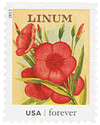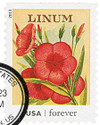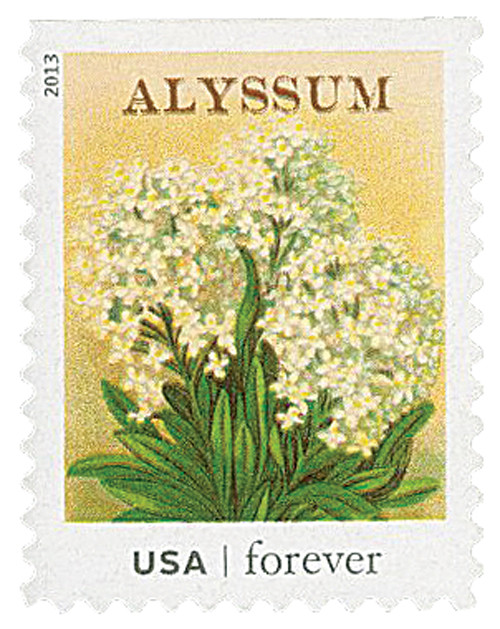
# 4757 - 2013 First-Class Forever Stamp - Vintage Seed Packets: Linum
U.S. # 4757
2013 46¢ Linum
Vintage Seed Packets
Commonly known as flax, linum originated in India and was brought to North America by the Pilgrims. It is a versatile plant, providing food, clothing, medicine, and linseed oil to the early settlers. Fibers from linum can also be used to make a variety of items, including rope and twine. The plant is rich in Omega-3, which helps fight many diseases, promotes heart health, and lowers blood pressure. Flax plants will not flower until their second year, but then explode in a riot of what gardeners call “true blue” color. The plant drops its flower seeds to the ground each year, reseeding for the following spring.
Vintage seed packets have grown in popularity over the years. Some people collect them – searching for packets in mint condition, from specific companies or with certain types of illustrations. Their fine artwork is also popular among decorators who frame them for a rustic look. They’re even used by scientists and historians to study these plants’ evolution.
U.S. Postal Service art director Antonio Alcala designed the Vintage Seed Packet stamps. He based these designs on photographs from 1910s and 1920s seed packets. The image for the linum stamp was based on a seed packed produced for Everitt’s Seed Store in Indiana.
Value: 46¢ First-Class letter rate
Issued: April 5, 2013
First Day City: Oaks, PA – Philadelphia Stamp Exhibition
Type of Stamp: Definitive
Printed by: Avery Dennison
Method: Photogravure printing in double-sided panes of 20 (convertible booklet format)
Perforation: Die Cut 10 ¾
Self-Adhesive
Quantity Printed: 40,000,000 stamps
Though not an established series, flowers have long been a popular subject for U.S. stamps. One of the earliest issues to feature a flower as a prominent design subject was U.S. #977, honoring Moina Michael, the founder of Poppy Day.
U.S. # 4757
2013 46¢ Linum
Vintage Seed Packets
Commonly known as flax, linum originated in India and was brought to North America by the Pilgrims. It is a versatile plant, providing food, clothing, medicine, and linseed oil to the early settlers. Fibers from linum can also be used to make a variety of items, including rope and twine. The plant is rich in Omega-3, which helps fight many diseases, promotes heart health, and lowers blood pressure. Flax plants will not flower until their second year, but then explode in a riot of what gardeners call “true blue” color. The plant drops its flower seeds to the ground each year, reseeding for the following spring.
Vintage seed packets have grown in popularity over the years. Some people collect them – searching for packets in mint condition, from specific companies or with certain types of illustrations. Their fine artwork is also popular among decorators who frame them for a rustic look. They’re even used by scientists and historians to study these plants’ evolution.
U.S. Postal Service art director Antonio Alcala designed the Vintage Seed Packet stamps. He based these designs on photographs from 1910s and 1920s seed packets. The image for the linum stamp was based on a seed packed produced for Everitt’s Seed Store in Indiana.
Value: 46¢ First-Class letter rate
Issued: April 5, 2013
First Day City: Oaks, PA – Philadelphia Stamp Exhibition
Type of Stamp: Definitive
Printed by: Avery Dennison
Method: Photogravure printing in double-sided panes of 20 (convertible booklet format)
Perforation: Die Cut 10 ¾
Self-Adhesive
Quantity Printed: 40,000,000 stamps
Though not an established series, flowers have long been a popular subject for U.S. stamps. One of the earliest issues to feature a flower as a prominent design subject was U.S. #977, honoring Moina Michael, the founder of Poppy Day.
















